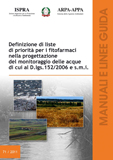Setting out of pesticide priority lists to plan the monitoring of waters according to D. Lgs 152/2006 and subsequent amendments

The “Setting out of pesticide priority lists to plan the monitoring of waters according to D. Lgs 152/2006 and subsequent amendments.” guidelines are an objective of the 2010 Detailed Operational Plan of the Pesticides Working Group – Monitoring and Environmental Controls area – B.4.2 – planning and management of monitoring networks for various environmental matrices. The scope is to establish the criteria for identifying a set of priority substances in terms of pesticides and their metabolites, to be monitored in different environmental matrices in relation to risk analysis and new directives on the subject.
Italian and European regulations on protecting water resources from pollution include phytosanitary products (pesticides) among the substances presenting the greatest risk for the water sector.
To effectively implement water monitoring plans according to D. Lgs 152/2006 and subsequent amendments, it is necessary on the one hand to adopt planning tools determining the areas at greatest risk and hence vulnerable and on the other to specify the active substances to be looked for. These should be selected according to priority criteria which bear in mind their potential risk in terms of contamination.
The results of previous monitoring and data on the use of pesticides on a local scale represent a precious background of information which, when supplemented by data on environmental behaviour data, the use of the land and crops, makes it possible to calculate pressure and impact indicators, in order to plan effective monitoring of bodies of water and active substances representing a risk.
The guidelines are a useful and easy to apply form of reference for those needing to plan water monitoring activities, with the objective of rationalising and optimising testing, targeting the active substances which may represent the greatest risk of contamination for the water matrix (list of priorities) in their own areas. With this objective in mind, a number of indices are proposed and the methods of use described in order to identify lists of priorities for the water sector.
The guidelines define the criteria to be used to identify priority substances searched for in the water and environmental sector, with selection of the most significant indicators and definition of priority indices.
The criteria presented can be divided into two classes:
1- indices linked to environmental pressure factors and/or to the environmental distribution of active substances (EURAM - COMMPS Index for surface waters, Index of Priorities (IP) for surface and underground waters, Priorities for underground waters, EPA California);
2- indices produced using the results of environmental monitoring and the Index of Water Contamination Risk, obtained using monitoring data (IRCA).
The guidelines also refer to other forecasting tools: GUS Index, Buffer Zones and indices linked to mathematical models and algorithms.
Publication available only on-line
Publication (ita)
